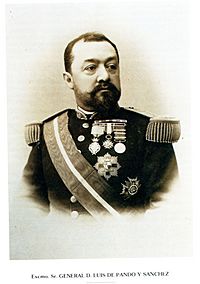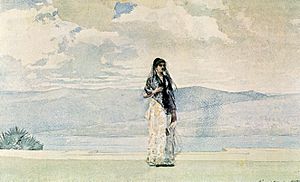Luis Manuel de Pando y Sánchez facts for kids
Quick facts for kids
Luis Manuel de Pando y Sánchez
|
|
|---|---|

General Luis Manuel de Pando y Sanchez
|
|
| Born | October 18, 1846 Ciudad Rodrigo, Salamanca, Spain |
| Died | January 16, 1927 (aged 80) Madrid, Spain |
| Allegiance | |
| Rank | Lieutenant-General |
Luis Manuel de Pando y Sánchez (born October 18, 1846 – died January 16, 1927) was an important Spanish general. He served during the Spanish–American War. He was also a Civil Governor of the Province of Santiago, Cuba.
General Pando was recognized for his bravery. He was even nominated for the Cross of San Fernando, a very high military award. King Alfonso XII promoted him to Colonel on the battlefield. He was also the youngest General in the Spanish Army at the time.
Contents
A Life of Service
Early Military Career
Luis Manuel de Pando began his military journey in 1861. He joined the Artillery Academy as a cadet. The next year, he studied at the Academy of Military Engineers.
By 1867, he became a Lieutenant of Engineers. He served in engineering groups until 1870. That year, he went to Cuba as a captain. He earned this promotion because of his bravery in local uprisings in Spain.
Fighting in Cuba and Spain
General Pando fought in the Ten Years' War in Cuba. This war lasted until late 1874. Over five years, he took part in many battles. He quickly rose through the ranks to commander and then Lieutenant-Colonel. He also received the Military Merit Cross.
He showed great courage in battles like Tempú and Jaquecito. He was even wounded in action on November 5, 1870. His bravery in battles at Arroyo Salado and Charco Redondo led to his promotion to lieutenant-colonel in 1872.
Because he was a skilled engineer, he also helped build and fix telegraph lines. He did this while still leading his mixed group of engineers and soldiers.
Pando continued to serve across Cuba. He took part in 65 battles. He received the Red Cross of Military Merit four times. After his service in Cuba, he moved back to Spain.
In Spain, he fought in the Carlist Wars. These were civil wars in Spain. He was known for his bravery in these battles. He helped capture important enemy positions like Monte Esquinza. He also helped a group of soldiers who were retreating in a messy way. He brought them back together and saved a difficult situation.
General Fajardo, his commander, praised him greatly. He said Pando "exceeded himself" and saved troops from being surrounded. For his actions, Pando was nominated for the Cross of San Fernando. King Alfonso XII promoted him to Colonel right on the battlefield.
A Young General's Rise
After General Fajardo left his command, Colonel Pando led a brigade. He worked under General Arsenio Martínez Campos in Catalonia. He fought in major battles of the Carlist Wars there. He also served in the Engineering Section of the army.
With his brigade, he captured Mirabent Castle. He also led the operations to take the city of Morella from the Carlists. Soon after, he conquered Cantavieja. He also took Puigcerdá and led the attack on Seo de Urgel. He captured Seo de Urgel after seven days of fighting. General Martínez Campos congratulated him in front of his troops.
On August 11, 1875, he led an attack on an enemy fort at Solsona. He fought fiercely and was seriously wounded twice. This campaign ended the Carlist Wars. General Martínez Campos quickly asked the government to promote Colonel Pando to brigadier. This was granted on the same day.
Pando became a general before he was thirty years old. He was the youngest general in the Spanish Army.
Peacemaking in Cuba
In 1877, after recovering from his wounds, General Pando returned to Cuba. General Martínez Campos put him in charge of operations in Guáimaro and Guantánamo. He served with distinction until the end of the Ten Years' War. He received the Great Cross of Military Merit. He was then made Civil Governor and military commander of Pinar de Río province.
In 1879, he took command of a brigade in Holguin and Tunas. His job was to bring peace to the area. A short war, called the "Little War," had started again there. General Pando used peaceful methods. He convinced Cuban leaders Peralta and Guerra, and their troops, to surrender. He was highly praised for this success. He also received the Great Cross of Isabel the Catholic.
After bringing peace to Tunas and Holguin, he went to lead the Guantánamo Brigade. His work there was more about politics than fighting. In just a few months, he convinced Generals Guillermo Moncada and José Maceo to surrender. Then, Luis Feria also surrendered at San Luis. General Pando went to their camps with only his assistants. He asked them to surrender as friends, avoiding unnecessary bloodshed. He showed them that fighting would not succeed. This ended the "Little War," which had lasted only eleven months. For his success in bringing peace, General Pando was promoted to field marshal on June 30, 1880.
Later Career and Politics
In 1881, while in Havana, General Pando traveled to the United States. He met with Grover Cleveland, who was expected to become the U.S. President. Cleveland was a friend of Spain. Their goal was to find a solution that would benefit Cuba, Cubans, the United States, and Spain. Cleveland suggested a "Great Sugar Treaty." This would help Cuba's economy. He also thought it would be wise to protect the new Panama Canal with a naval base near Cuba.
At the end of 1881, Pando was named Civil Governor and military commander of Santiago de Cuba province. He held this position until May 1885. Then he returned to Spain and held various other jobs.
From 1886 to 1898, he was elected as a representative in the Spanish Parliament. He represented the provinces of Pinar del Río and Santiago de Cuba.
In 1891, he was promoted to lieutenant-general. This was based on his many years of service. He had also been elected as a Senator for different provinces in Spain.
As a lieutenant-general, he held high military positions. He returned to Cuba when Martínez Campos became the main commander at the start of the War of Independence. Martínez Campos put Pando in charge of two army corps.
He later returned to Spain. He then came back to Cuba with General Blanco. He served as the main military advisor for the Army of Operations in Cuba. However, General Blanco and General Pando had a disagreement. Blanco refused Pando's request to send more troops to Santiago to defend against an invasion.
For his many achievements during the war, he received the Great Cross of Military Merit.
Personal Life
In 1885, General Pando married a French woman named Cecilia Armand-Roche. They had one son, Francisco de Pando y Armand. Their son later became a very important leader in Cuba's sugar industry.
See also
 In Spanish: Luis Manuel de Pando y Sánchez para niños
In Spanish: Luis Manuel de Pando y Sánchez para niños


